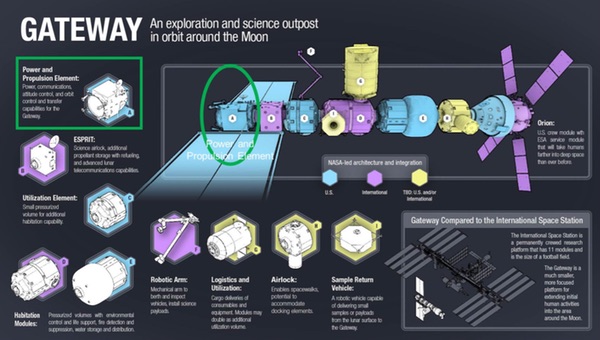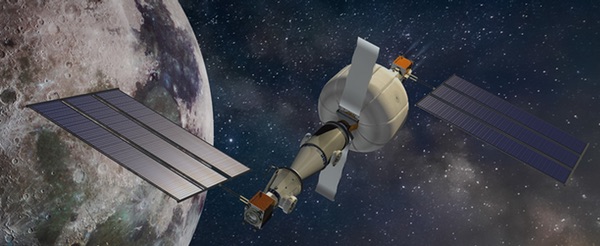Powering the first element of the Gatewayby Jeff Foust
|
| “The PPE is a great opportunity to develop both new capabilities that benefit NASA at the Moon, but benefit Mars exploration and benefit commercial operations as well,” said Lockheed Martin’s Cichan. |
The PPE, as its name suggests, will provide power and propulsion capabilities to the Gateway. NASA specifically plans to use electric propulsion to enable it to move the Gateway to different orbits in cislunar space, in the process demonstrating that capability for later exploration missions. The PPE will provide power for the rest of the Gateway as well as other services, like communications.
“We’re leveraging advanced solar electric propulsion technologies that have been developed and matured over the years,” said David Irimies, deputy manager of the PPE at NASA Glenn, during a panel discussion about the effort July 11 at the AIAA Propulsion and Energy Forum in Cincinnati. That includes work done on the Asteroid Redirect Mission (ARM), whose robotic component also planned to use solar electric propulsion to travel to a near Earth asteroid, collect a boulder from its surface, and return to cislunar space.
The baseline concept for the PPE is a spacecraft capable of generating 50 kilowatts of power for use by the propulsion system and the rest of the Gateway. It would use a solar electric propulsion system based on technologies developed by Aerojet Rocketdyne requiring 40 kilowatts of power, as well as chemical thrusters. It would support communications both back to Earth and with visiting vehicles, and have a 15-year life.
Several companies have a head start on developing their PPE designs through study contracts NASA awarded last year as part of the Next Space Technologies for Exploration Partnerships, or NextSTEP, program. Those studies, which wrapped up earlier this year, allowed companies to give feedback to NASA on both technical issues as well as commercial applications for the PPE, which the agency seeks to develop through a public-private partnership versus a traditional contracting scheme.
Four of the five companies that received NextSTEP PPE awards last year—Boeing being the exception—discussed their efforts at the AIAA conference panel, showing the different approaches they planned as well as the commercial possibilities for the PPE.
“The PPE is a great opportunity to develop both new capabilities that benefit NASA at the Moon, but benefit Mars exploration and benefit commercial operations as well,” said Tim Cichan of Lockheed Martin. “From our perspective, the challenge of the PPE is to look across Lockheed Martin’s experience in different areas to get to the most affordable solution possible.”
Cichan said the company is leveraging is experience using smaller electric propulsion systems on commercial satellites, and plans to use commercially available solar arrays for its PPE concept. It’s also taking advantage of its work on Orion to develop a system that would meet NASA safety requirements for what will eventually be a crewed platform.
“One of the experiences from Orion was how do we design a human-rated system with very challenging design constraints,” he said. “We figured out how to get the right reliability without having triple-redundant systems everywhere.”
Another issue, he said, was figuring out how to incorporate its products, like its LM2100 satellite bus series, into the PPE. “That’s very much how the PPE is based, but where do we pull in the interplanetary systems or operations, or human systems or operations?”
| “We see the PPE opportunity as one that will bring us from the markets in LEO and GEO and enable us to expand our mission portfolio out to cislunar space and beyond,” said Richardson. |
Northrop Grumman Innovation Systems (NGIS, formerly Orbital ATK) plans to leverage its ongoing work developing satellite servicing technologies for use on the PPE. The company’s PPE concept is based on the Mission Transportation Vehicle, an advanced version of the Mission Extension Vehicle it’s developing for extending the life of satellites in geostationary orbit.
“While on the one hand we’re designing for a single point solution, which is the first element of the Gateway, we’re also looking at how we can leverage our commercial product lines,” said Sally Richardson, vice president and program manager for advanced program division at NGIS. “We saw that as a huge opportunity. By utilizing this commercial, public-private approach, we’re looking at a more economical solution for this element of the Gateway.”
Although Northrop Grumman wants to incorporate its own systems into the PPE, it sees the element as one way to evolve those systems, in particular by incorporating high-power solar electric propulsion. “We see the PPE opportunity as one that will bring us from the markets in LEO and GEO and enable us to expand our mission portfolio out to cislunar space and beyond,” she said.
Sierra Nevada Corporation (SNC) plans to make use of technologies it’s developing for other programs. “When we first started PPE last year, it quickly became obvious that to us that we were going to need to this program a little bit differently,” said Kevin Clinton, citing the program’s budget and schedule. “The programmatics on the NASA side simply don’t support a traditional spacecraft development program.”
SNC’s version of the PPE makes use of a conical module that the company is developing as part of the Dream Chaser cargo delivery system for the ISS. For the PPE, it will house avionics and related hardware, as well as additional pressurized space that he said offers “mission flexibility” for the Gateway. That module would be attached to a separate structure that houses the propulsion elements.
“We had this available, off the shelf. It was already designed,” he said, requiring only modest modifications for use on the PPE.
Like the other companies, Clinton said he saw applications for the PPE beyond the Gateway. “We see a lot of similarities between what NASA’s CRS-2 program for cargo delivery did for us in LEO, and what the PPE can do for us in cislunar space,” he said. Just as NASA’s Commercial Resupply Services 2 contract enabled the company to develop the cargo version of Dream Chaser and create opportunities for additional business, the same may be true for the PPE.
He acknowledged, though, that the potential business case for commercial activities in cislunar space remained uncertain. “There is a not a ton of Harvard Business Review case studies on how to best commercialize the Moon,” he said. “We’re basically creating a market.”
Space Systems Loral (SSL), the commercial satellite developer that is a division of Maxar Technologies, took advantage of its own experience with electric propulsion as well as development of satellite servicing technologies for its PPE study. “NASA has very intentionally, and very significantly, looked at doing this acquisition differently,” said Al Tadros, vice president for space infrastructure and civil space at SSL, citing a desire to leverage commercial capabilities for the PPE.
He emphasized that the PPE was not simply a repurposed ARM spacecraft. “The ARM mission was quite different from the Gateway mission,” he said. “Also, what the potential applications of the PPE would be across NASA’s missions, as well as what we in commercial industry are thinking about.”
| “NASA has a lot of business upcoming with our future exploration campaign that we’re going to be rolling out details in the very near future,” Bridenstine said. |
With the NextSTEP studies complete, those companies are looking ahead to the PPE solicitation. According to NASA documents presented at the industry day, the agency expects to issue the final version of the BAA on or around September 6. Proposals would be due November 8, with NASA making an award next March.
Those documents, though, gave a hint of changes to the overall Gateway concept. The illustrations presented by the companies at the AIAA panel typically showed the PPE as part of a minimalistic Gateway, accompanied by a habitation module, logistics module, and airlock, the same concept that NASA has been publicly showing for some time. The companies offered their own riffs on that: SNC, for example, is looking at developing expandable (or inflatable) habitation modules that would be used for the Gateway.
 A NASA illustration of all the potential modules that could be included in the Gateway, including both commercial and international contributions [larger version]. (credit: NASA) |
However, NASA has also been showing a more complex version of the Gateway as well. The PPE industry day presentation included one that showed several additional modules, including one called ESPRIT that offered additional propellant storage, a “science airlock,” and advanced lunar telecommunications capabilities. This Gateway concept also features an additional logistics module and habitation module, a robotic arm, and a sample return vehicle that could transport items between the Gateway and the lunar surface.
Some of those additional components could be provided by international partners. Which partners and which modules, though, remain to be determined, but NASA administrator Jim Bridenstine recently suggested that those details could be released soon.
“NASA has a lot of business upcoming with our future exploration campaign that we’re going to be rolling out details in the very near future,” he said in a video he posted from London just before the start of the Farnborough International Airshow last week, which he attended and held meetings with a number of companies and international agencies.
“We’re putting together concepts and ideas from our international partners for who can plug in where,” he said in a brief interview at the air show. When is the “very near future” that he referenced? “Maybe in September,” he responded.
That schedule means it could influence the planning by the companies intending to bid on the PPE that will be the first element of that Gateway, in whatever shape that cislunar facility takes.
Note: we are temporarily moderating all comments subcommitted to deal with a surge in spam.
